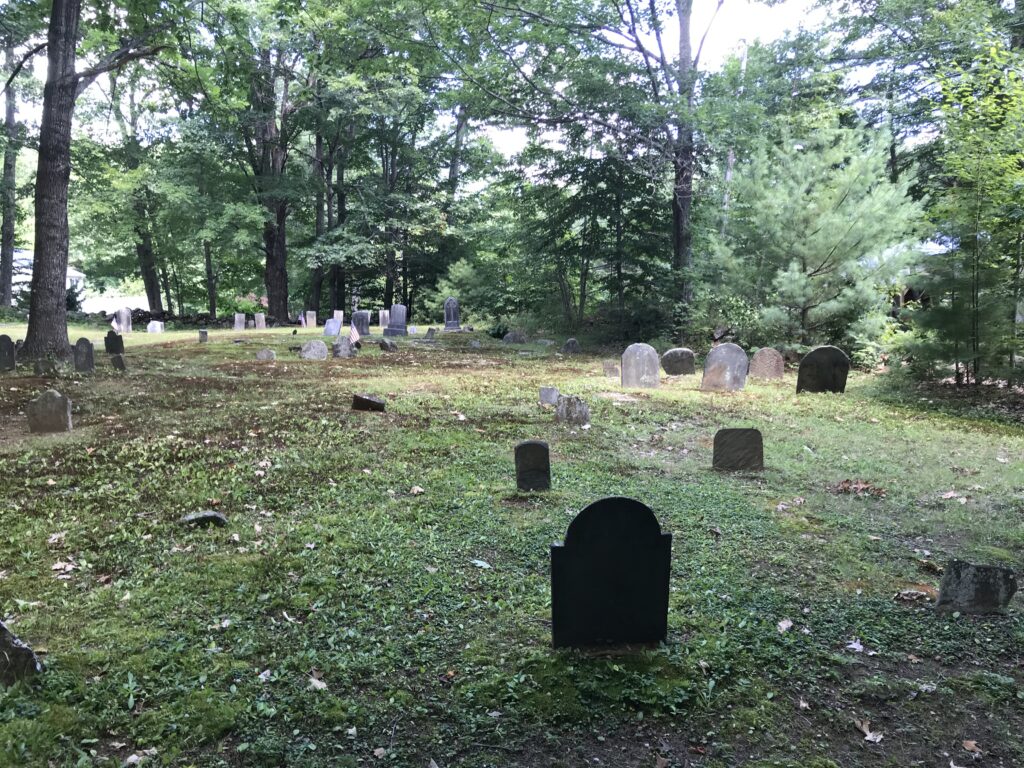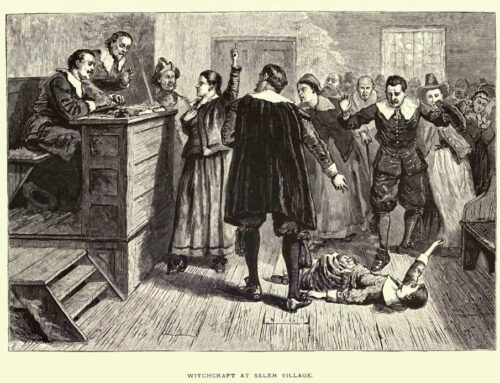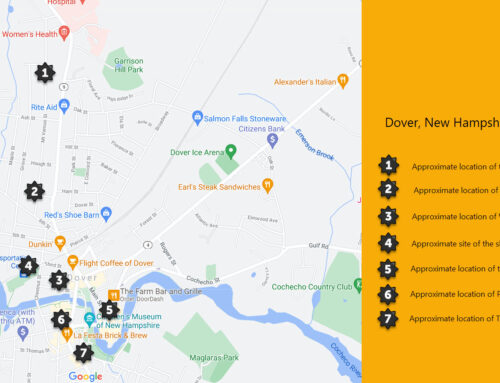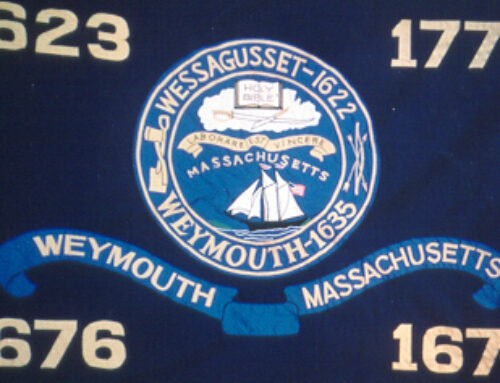
In this exhausting year of 2020, Jim and I have done our best to social distance to help prevent the spread of Covid-19. This summer has been especially isolating, though. In a season that we would normally spend lots of time with friends and family, the days have been blending together with a bland sameness. So, we have started spending weekends at Lazy Frog Campground in Lebanon, Maine. Although it is only 25 minutes from our home, having people around us at other campsites has helped to break the boredom and isolation.
This post was inspired by my drive here Friday afternoon, on the back country roads, sun shining, the sweet smells of the hay freshly cut in the fields I was passing wafting in through the open car windows. I love this place where we live. I’ve traveled the world and love the adventure of experiencing new places and cultures. But I feel a deep connection to New England that I am certain comes from the many generations of my ancestors who have lived and died here too.
This place was originally called Towow (or Towwoh) by the local Abenaki tribe who had a village just a little further down what is now the Salmon Falls River (called Newichawannock by the Abenaki, a word that meant “river with many falls”).
According the George Walter Chamberlain who published The Beginnings of Lebanon, Maine in 1936, the area we now know as Lebanon was first granted in 1733 by the General Court of Massachusetts Bay as the “Township at the Head of Berwick” to a group of 60 families given the charter. It was another decade before they began settling the area in 1743, the first meeting house was built in 1753, several garrison houses by 1755, and the first parsonage in 1759. The town of Lebanon was incorporated on July 17, 1767 as Maine’s official 23rd town.
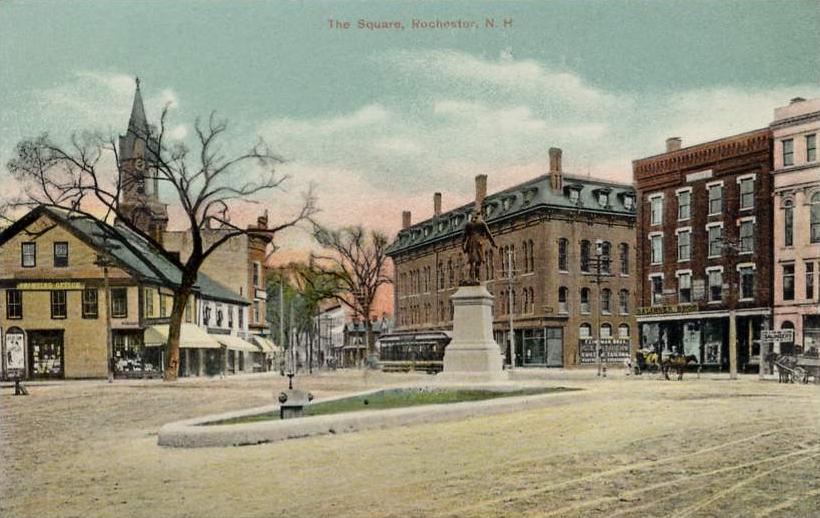
Central Square, Rochester, New Hampshire; from an original c. 1908 postcard published by G. W. Morris, Portland, Maine. The Parson Main Monument, by sculptor Giuseppe Moretti, was erected in 1896. Still a familiar site in Rochester in 2020.
The first preacher to conduct services in the meeting house was Reverend Amos Main from adjoining Rochester, New Hampshire. Rev. Main is our ancestor; my 8th great grandfather on my mother’s side. A physician as well as a minister, Reverend Main kept written records of his travels throughout the region, and so we know he baptized several children in what is now Lebanon, between the years of 1753 and 1757, in addition to providing physician services to 11 families between 1753 and 1759. Reverend Main, who has been honored with a statue in the middle of Central Square in Rochester, was a fascinating character worthy of his own blog post, which I will write in the future.
The Corson family (also sometimes spelled Courson or Corsen), from whom I am also descended on my mother’s side was among the first group of settlers in Lebanon, prior to the official incorporation of the town. Zebulon and Mary (Tibbets) Corson, my 8th great grandparents, moved with their adult son’s family to the settlement of West Lebanon in about 1760, the same year Reverend Main died of consumption and was shortly after replaced by Reverend Isaac Hasey, a Harvard graduate. It was thanks to the records kept by Rev. Hasey that we have a record of Zebulon in Lebanon, as he made note of visiting them several times, even baptizing Zebulon as an adult on June 27, 1773.
The First Parish Congregational Church was established in 1765, with the arrival of Rev. Hasey who ministered to the parish for the next 47 years, keeping careful records that today provide a great deal of the genealogical evidence we rely on for family history in Lebanon.
It is ironic that I have come to this campground to break my sense of isolation, when my ancestors would have had exactly the opposite experience, surely feeling quite isolated in what was known at the time as “frontier” country, subject to attacks by the local Native American tribes. This is, in fact, the reason for the delay in their settling the area. Although the last recorded attack had been in bordering Rochester, on June 26, 1746, it was a constant threat that the people at the time took very seriously. The French and Indian War was winding down in 1760, perhaps making the Corson family’s decision to move to West Lebanon where they built a log cabin and cleared the land, much easier.
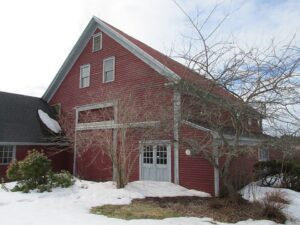
Tuttle’s Farm. By John Phelan – Own work, CC BY-SA 3.0, https://commons.wikimedia.org/w/index.php?curid=24965070
Zebulon Corson was born in nearby Dover on June 12, 1712, the grandson of the infamous Cornelius Corson whom I wrote about in my introduction to this website, a major player in my original fascination with genealogy decades ago. Zebulon’s wife, Mary Tibbets, was born November 18, 1718, also in Dover. Mary was the granddaughter on her mother’s side of John Tuttle, well known in this area as the original proprietor of Tuttle’s Farm in Dover, which when it was sold in 2013, was distinguished as the nation’s oldest continuously running family farm passed, over 380-some years, through 11 generations of family.
Mary’s father, Samuel Tibbets, was a tanner with a large tannery located at Dover Neck (the area of Dover we now often refer to as Dover Point). He was also a Captain in the French and Indian War, a deacon in the church, and a deputy in the New Hampshire Colonial legislature for several years.
Zebulon himself, was described as a laborer, and on July 23, 1746 was recorded as being in the Somersworth Army under the command Colonel Thomas Wallingford, which I believe is a reference to the local militia as opposed to any actual military service (NOTE: Thomas Wallingford was also the grandson of John Tuttle, so he and Mary Tibbets were cousins).
Zebulon and Mary had been married in 1738 and lived in the Somersworth area of Dover (at the time, Somersworth was an administrative district of Dover), becoming the parents of 4 sons and 1 daughter. Many online trees also attribute two more sons to them, but I have yet to find solid evidence that they are of the same family. We are descended from their oldest son Samuel, born in 1738 in Dover.
Samuel and his wife Mary (Wentworth) Corson were my 7th great grandparents and the first of the family to move to West Lebanon in about 1760, bringing their parents with them, with other siblings following them later. Born in 1735, in Dover, Mary was the great granddaughter of Elder William Wentworth, the first Wentworth recorded in America on July 4, 1639, and the ancestor of the legendary Wentworth family of New Hampshire (I plan to write a future blog post about this fascinating ancestor, as well).
Married in approximately 1760, Samuel and Mary were the parents of 7 children, 3 boys and 4 girls (we are descended from his oldest son Levi born November 8, 1761).
Samuel predeceased both of his parents, dying March 20, 1785 in Lebanon. He was only 47 at the time and no cause of death was listed. His son, Levi (our ancestor) was the probate administrator for his father’s estate, which he inherited. Samuel’s wife Mary lived for close to 20 more years, dying on Feb 11, 1804 in Lebanon at the age of 69.
On Jul 28, 1784, Rev. Hasey wrote that Zebulon Corson said he ‘heard a chorus of Angels’ and after Zebulon became speechless, he “visited and prayed with him.” Zebulon died at the age of 74, on April 28, 1786, from what was described as “decay of nature.” Mary lived for another 17 years after her husband passed, dying on January 11, 1803 in nearby Shapleigh, Maine where she was living with her son Moses.
Most of the Corson family is said to be buried in the Camp Hill Cemetery at the corner of Shapleigh Road and Gully Oven Road, which I visited this weekend. Many of the earliest settlers of Lebanon are buried here. Unfortunately, many of the oldest gravestones are unreadable or destroyed, but I did find the markers for many Corsons of later generations, including Levi’s oldest son Samuel (1785-1850). Born just 7 months after his grandfather’s death, he was named after his grandfather.
Of course, the Corson family does not make up the entirety of roots in Lebanon, they are just the earliest settlers I was able to find among our ancestors.
Others include Solomon Hartford, my 6th great grandfather. Solomon was born in Rochester, on February 18, 1740, the great grandson of the previously mentioned Elder William Wentworth, through another line. On September 13, 1774, he married Mercy Farnham (born May 19, 1753 in Rochester) in Lebanon, so it is reasonable to believe he was living in Lebanon at that time. We know for certain he moved to the town sometime prior to 1776, where he enlisted as a private in Captain John Brewster’s Company of Colonel Pierce Long’s Regiment, stationed at New Castle, New Hampshire during the Revolutionary War. Solomon and Mercy lived in West Lebanon, where it is said he lived on the Moses Ricker Farm. At some point, he and Mercy moved to Lancaster, New Hampshire, but after he died in 1832, his body was returned to Lebanon, where he is buried in an unmarked grave on the Ricker Farm (I haven’t yet determined the relationship between Solomon and the Rickers, and haven’t identified exactly where the Ricker farm was located; perhaps someone reading this can help). Solomon and Mercy were the parents of 11 children. We are descended from their daughter, also named Mercy, born in Lebanon on October 1, 1786.
Jeremiah and Elizabeth (Guptil) Libby were my 7th great grandparents. Jeremiah was born on December 28, 1747 in Berwick, where he was a blacksmith. He married Elizabeth Guptil in 1767, in Berwick, and in 1789, the family relocated to Lebanon where he served a term as selectman. Jeremiah died on December 14, 1816 in Lebanon, at the age of 69. Elizabeth, who had been born in 1746, outlived her husband by 12 years and died on October 14, 1828 in Berwick.
The Shorey’s of Lebanon are another family name that figure prominently in our early history in Lebanon. Stephen Shorey, born in 1763, married Abigail Libby, daughter of Jeremiah and Elizabeth (Guptil) Libby. They are my 6th great grandparents. Stephen and Abigail raised their family of 4 in Lebanon, where all the children were born. Stephen died on September 27, 1803 in a freak accident in which he was run over by a cart and killed instantly.
Even the Tucker family would end up in Lebanon by the mid-to-late 1860s. I’ve written extensively about that branch of the family in another blog post.
As the saying goes, wings show you what you can become, roots remind you where you are from. Many people spend their lives dreaming about visiting their ancestral homes—the places where their ancestors lived, loved, and worked. They say it can be a life-changing experience and that those places can immediately feel familiar, even if you have never been there before. I know that feeling of familiarity because I have experienced it my entire life.
I am incredibly fortunate to still live where many of my ancestors lived. As I wander through the ancient burial grounds, even when the oldest grave markers are gone, I know that I am walking over the ground where my ancestors were laid to rest. As I a walk through the forests all around me, I wonder at the stone walls that criss-cross them, knowing that they once marked the boundaries of fields that my ancestors and their contemporaries manually cleared—a feat that seems almost unimaginable now. I stop and explore the old stone foundations that are often found in the most unexpected places, knowing that any one of them may be the home of one of my ancestors. This intense sense of home never leaves me.
And finally, throughout this post I have been writing about the ancestors on my maternal side. But, sitting here, writing this post on my laptop at my campsite at Lazy Frog Campground, I am a five minute walk from Forest Grove Cemetery, the burial place of my paternal grandparents, Henry and Lucinda (deRochemont) Laviolette, who moved to Lebanon after marrying and raised their family here (my father included). The roots are deep and broad, and span both sides of my family.

